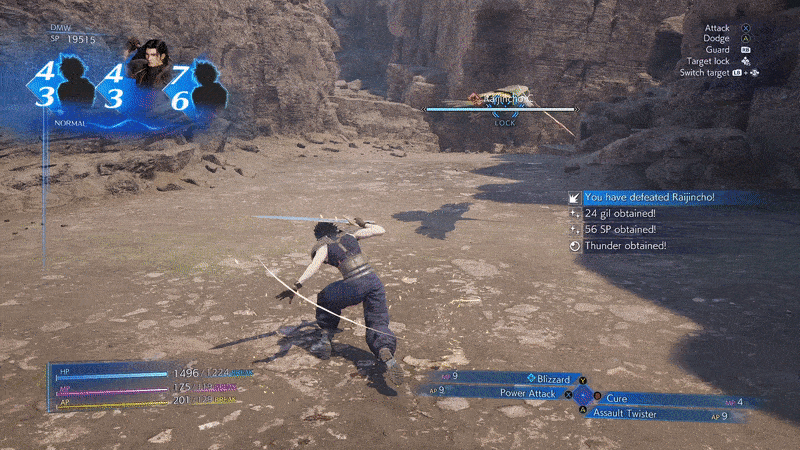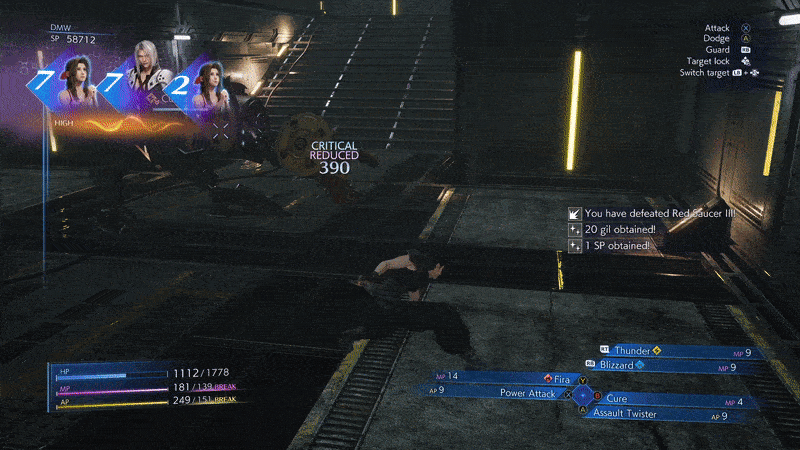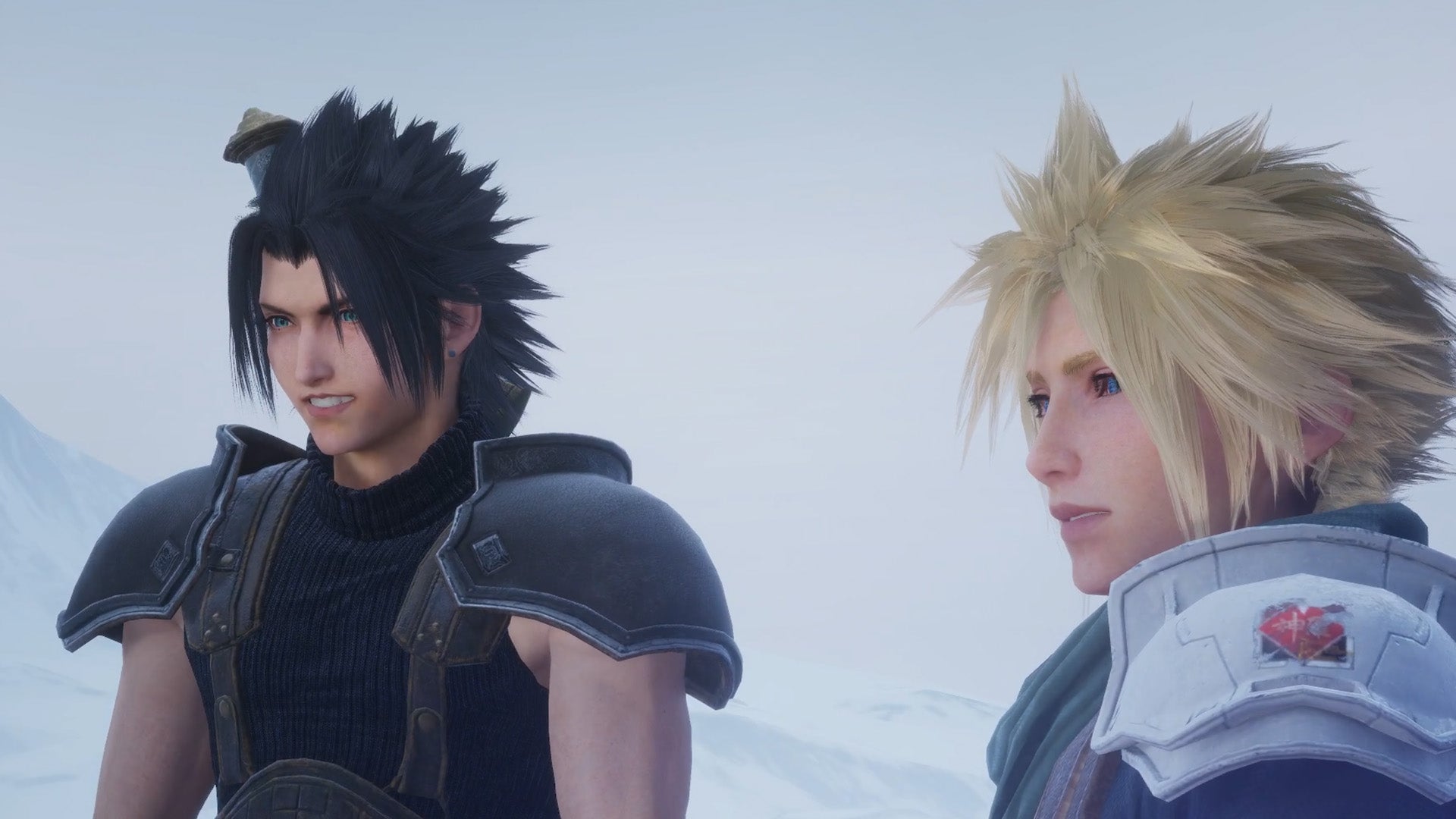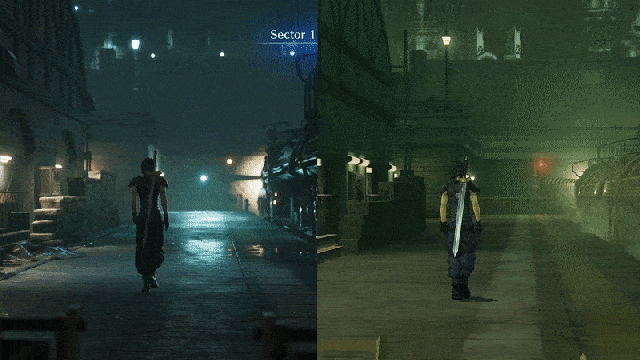As a prequel to one of the most beloved video game stories of all time, It’s important that Crisis Core – Final Fantasy VII – Reunion tell its own prequel story without disrupting the thematic cohesion of the story that spawned it. Does it succeed? Mostly. Reunion excels at being a great RPG and a phenomenal remaster. Yet its story decisions, much as they did when the game originally launched on the PSP, stomp on Final Fantasy VII’s plot far too often and attempt to fill it with shenanigans that distract from many of VII’s themes and central characters. Crisis Core selfishly indulges in its own contributions to VII’s mythos by failing to learn from what made the original Final Fantasy VII so impactful and beautifully tragic in 1997. Yet, it’s a game you shouldn’t miss out on because for all of its late-stage missteps, many of its characters are still hard not to love, and they come packaged in an exciting and very pretty RPG.
Crisis Core returns to us as Reunion: a remaster of a PSP game that first launched in 2007 as a prequel to 1997’s Final Fantasy VII, a generation-defining titan of a JRPG. Having never received a digital release on the PlayStation store, the PSP-exclusive UMD discs Crisis Core shipped on have been the sole keepers of a very important chapter of the game’s larger saga.
Today, Crisis Core emerges from its slumber and wakes up in a very different world. In the 15 years since the game first released, we’ve seen a full reimagining of Final Fantasy VII’s opening chapter with Remake. As a narrative, that 2020 version of VII brought us more expanded, and questionable, story beats; as a video game it delivered a remarkable form of command-based, real-time combat. With Reunion, Crisis Core no longer exists solely alongside the original Final Fantasy VII. It can now stand on its own as a lovely JRPG that might even balance out Remake’s unique twists and turns, at the cost of perhaps disrupting the themes in 1997’s original Final Fantasy VII.
[review heading=”Crisis Core -FINAL FANTSY VII- Reunion” image=”https://www.kotaku.com.au/wp-content/uploads/sites/3/2022/12/14/e108fca772dbd344a4e418497081abaa.jpg” label1=”Back of the box quote” description1=””It’s Final Fantasy VII, but the protagonist isn’t gaslighting you.”” label2=”Developer” description2=”Square Enix” label3=”Type of game” description3=”JRPG” label4=”Liked” description4=”Great combat, wonderful characters.” label5=”Disliked” description5=”The story’s conclusion messes too much with the original Final Fantasy VII.” label6=”Release Date” description6=”December 13, 2022″ label7=”Played” description7=”Finished the story and an estimated 20 per cent of the side missions. Logged just over 18 hours.” label8=”Platforms” description8=”Switch, PS4, PS5, PC, Xbox One, Xbox Series X/S” ]
Before discussing any element of Reunion individually, I want to stress how stellar it is as a remaster. Compared to similar remasters like Final Fantasy Type-0 HD (also a PSP-originated game), or even remasters of X, XII, and VIII, Reunion plants its flag in the ground as a new standard for remasters of Final Fantasy games (if not games in general). Reunion often looks so good that you’d be forgiven if you thought you were playing a modern AAA title from time to time, and it runs flawlessly on PC (something we can’t always take for granted with Final Fantasy games).
Reunion doesn’t surpass Final Fantasy VII: Remake in visual quality, but it certainly comes close to matching it many times. Add to that the brand new menu and UI elements that take their beats from Remake’s theming, and a gentle, liberated twist of Crisis Core’s combat system, and it makes creative director Tetsuya Nomura’s classification of Reunion as being “closer to a remaster than a remake” seem a little unfair to Reunion. Preserving all of Crisis Core’s main story beats (unlike Remake did with FFVII) is largely what prevents this from being a complete remake. And honestly, I kinda wish they would’ve revised this story.
But before we dive into that, let’s address what many might be most concerned about: As Crisis Core was originally designed to be played on-the-go and featured a somewhat experimental combat system, how does it fare now as a full console game? While I think Reunion might still be best experienced on a portable, like the Switch or Steam Deck, it works just as well on a big screen as a more theatrical presentation. The quick side missions, limited size of battle environments, and some level layouts clearly reveal that this was designed with a smaller scope in mind and thus is a more natural fit for a tiny, portable experience. Yet these hardly make you feel like you’re playing something wildly out of time and place.
The main story is a roughly 18-hour experience (which you should definitely not cram into a weekend — ask me how I know). Crisis Core follows the story of Zack Fair. If you haven’t played through the original Final Fantasy VII and think Zack looks like Cloud with black hair, you wouldn’t be wrong. Without giving too much away, it’s important to know that Zack plays a critical role in the events that lead up to Final Fantasy VII. In Crisis Core – Reunion you’ll guide Zack through a winding narrative focused around genetically enhanced super soldiers and various disasters that unfold. There’s a main story to follow, and many side missions you can jump into for quick battles and focused grinding sessions.
The heart of the game is in its main quest, which leads right up to the opening of the original Final Fantasy VII (or perhaps Remake, depending on how you view certain artistic changes to Crisis Core). The side missions, accessible at nearly every save point, are mostly just quick sprints through environments to fight a handful of battles (though some later ones have longer, more challenging encounters). They do tie into the narrative, but only in the brief explainer text visible in the mission selection menu. But don’t dismiss them. They let you isolate your grinding while serving as a bite-sized way to check in and check out of the game. I would’ve preferred to keep all the grinding in these side missions, but alas, Reunion suffers from far too frequent random encounters during the narrative levels.

Like Final Fantasy VII, Reunion uses “materia,” magical earth orbs that grant the use of magic spells as well as elevated combat abilities, utilities, and stat boosts. You can choose which materia you slot into Zack, and those magical orbs can also be leveled up, and even fused together to create new materia. Want a thunder spell? Equip thunder materia and you can now cast it by holding down a command button and hitting the face button you’ve assigned it to. You can basically design your own control layout, with five different “sets” of materia and button commands available for different builds of your design. Though you can’t switch these sets on the fly, you can change them up when not in combat or when restarting after a game over. It’s mechanically rewarding as an RPG speccing system and very easy to access in real-time combat.
And those spells also have a surprising amount of physicality to them, so much so that the usual rock, paper, scissors aspect of elemental magic common to most RPGs isn’t the only thing to consider. Take “blizzard” for example, an ice-based spell attack. When cast, it forms a large ice crystal above an enemy’s head and drops it on them for damage. If you cast this and an enemy moves, they basically dodge your spell attack. This means that you can’t just spam buttons, you need to anticipate and study enemy movement. Another example is “thunder,” which gives Zack a Star Wars-y force-lightning-like attack that only has a range of a few feet. You can easily cast this to no effect if an enemy isn’t within range.
This has the benefit of making combat dynamic and somewhat unpredictable. It’s not quite as lively and fluid as Remake’s combat, but it certainly feels more thrilling and reactive than even the original PSP version did — though much of that is due to improved character models and animations. Dodging and blocking also plays a pretty significant role. However, sometimes those spinning slots in the upper corner of the screen will give you random boosts that mean you don’t need to block as often.

That brings us to the DMW, or Digital Mind Wave. In my estimation, Crisis Core’s unique slot-based combat system is a little less arduous and distracting than it was in the PSP original. Gone is the original release’s “modulating phase” that stopped combat. The Digital Mind Wave remains, however, with its randomised, slot-machine-style chance for you to get bonuses like HP boosts or temporary invincibility. This adds another level of unpredictability to the combat that doesn’t just shower you with gifts, but asks you to make the most out of what it gives you. DMW gave you unlimited MP? Then it’s time to hit those healing spells or spam your best damage-dealing materia. Invincibility? It’s time to jump in and whale on your enemies without any concern for your health.
When the portraits in the Digital Mind Wave all match, say three instances of Sephiroth (Final Fantasy VII’s antagonist) or Angeal (Zack’s mentor), you’ll get access to a limit break (or summon if it’s a summon portrait). Limit breaks are themed to the character whose portrait matches, and you can hear them giving a kind of pep talk to Zack when you trigger them. Sephiroth grants an omnislash-like ability (the ultimate limit break in Final Fantasy VII); Aerith grants full healing (like her limit break in VII), and so on. You can earn “SP” to feed into this system, but here’s the secret: You can also largely ignore the whole slot thing and just play this like a command-based action RPG.
Seriously, for most of my playthrough I just let those slots do their thing, occasionally noticing that a limit break was ready or that I had some random buff to my stats. I’d been worried that this slot thing would be some other weird system I’d have to manage, but you don’t. It’s just a visible RNG system in what plays as a solid action-RPG.
The DMW is also narratively consistent. A vital theme in Final Fantasy VII is memory and identity. Characters’ perspectives and memories of who they are, and who they are in relation to other characters, is what defines their motivations. Final Fantasy VII’s story is fundamentally about characters who must understand that they are shaped and defined by their interactions with each other, and that they need to come together to surpass the challenges of a world in crisis.

No character is an island, even if they might think they are. The promises, hopes, and failures characters share with one another, and how those memories surface (and are abused by a certain antagonistic force) and develop are a central part of VII. This is brought into combat via a system that links inspiration and memory. It makes every limit break not just an execution of an ultimate ability, but a window into how different characters have shaped and influenced Zack.
We start the game with Zack as an impressionable young man with “unattainable goals.” Every limit break that pulls from memories of his mentor, his friends, or his romantic desires shows what he’s fighting for. And it’s what makes Crisis Core successful as a work of tragedy, despite my issues with the plot. Zack is hopeful, confident, not just because those are his character traits, but because he’s inspired by those around him. That’s why he’s a hero, defined by those who’ve made him into one and those who look to him as one. It’s not because he’s your main character with the big sword, but because he never, not once, fails to think about the people in his life. And it’s what dramatically differentiates him from the protagonist of VII, Cloud Strife. The importance of being connected to others is what Cloud must learn in VII. But unfortunately, Crisis Core’s narrative intrudes a bit too much on VII.
For all of its strengths, Crisis Core is ultimately too obsessed with itself to serve as a perfect prequel. The game’s core narrative is an excellent half or three-quarters of a story. The final plot arc, however, fails to recognise that VII is its own story with its own characters. Crisis Core’s depiction of VII’s characters, and its refusal to stop shoving new characters into existing narratives, makes for a disappointing conclusion.

Crisis Core should be taken seriously since its promises are serious. If you’ve played Final Fantasy VII, then you know this chapter of the story shows us the person Cloud, VII’s protagonist, thought he was: Zack Fair. We play as Zack all the way up to the final fight that sees him killed, leaving Cloud alone, confused by trauma and some sci-fi magic mumbo jumbo that makes him believe Zack’s memories and even identity are his to inherit and mimic.

Unfortunately, Crisis Core, much as it did in 2007, seems to be more interested in retconning VII than it is in contributing to the original, much-loved story. This is particularly notable in the Nibelheim chapter, which begins very much like a sequence set in the same location in Final Fantasy VII. The undying villain of the game, Genesis, who continues to repeat the same lines in almost every scene he’s in, appears (out of nowhere) in the reactor that houses FFVII menace Jenova…to continue to repeat the same lines over and over again. If we’re keeping score, this is the third time that this particular scene is reexplained for the player: Once in Final Fantasy VII through the false memories of Cloud. Again when Cloud is finally ready to understand that Zack was actually in his place during these scenes. Now Crisis Core wants to add that not only was Zack there, but Genesis, who’s not an antagonist in VII, is also there. It denies VII the authority to tell the story and is an unneeded revision. Genesis is an ok antagonist for half of Crisis Core, but he’s not a suitable antagonist for VII, which is what Crisis Core implies by inserting him into VII’s own scenes.
Sadly, the end result of Crisis Core is an overcomplication of the story established in Final Fantasy VII, filled with various details that just amount to more history lessons and homework to be able to make sense of everything. Its undying antagonists and plot points that refuse to be resolved (Genesis’ fate is uncertain in the end) weaken the role of death. When we consider that so much of what made Final Fantasy VII impactful was the irreversible death of an important character, it’s hard to walk away from Crisis Core with the impression that anything is meaningful or at risk of loss in this world.

Leave a Reply